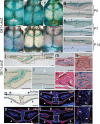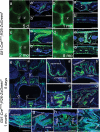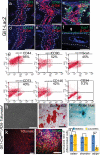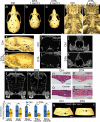The suture provides a niche for mesenchymal stem cells of craniofacial bones
- PMID: 25799059
- PMCID: PMC4380556
- DOI: 10.1038/ncb3139
The suture provides a niche for mesenchymal stem cells of craniofacial bones
Abstract
Bone tissue undergoes constant turnover supported by stem cells. Recent studies showed that perivascular mesenchymal stem cells (MSCs) contribute to the turnover of long bones. Craniofacial bones are flat bones derived from a different embryonic origin than the long bones. The identity and regulating niche for craniofacial-bone MSCs remain unknown. Here, we identify Gli1+ cells within the suture mesenchyme as the main MSC population for craniofacial bones. They are not associated with vasculature, give rise to all craniofacial bones in the adult and are activated during injury repair. Gli1+ cells are typical MSCs in vitro. Ablation of Gli1+ cells leads to craniosynostosis and arrest of skull growth, indicating that these cells are an indispensable stem cell population. Twist1(+/-) mice with craniosynostosis show reduced Gli1+ MSCs in sutures, suggesting that craniosynostosis may result from diminished suture stem cells. Our study indicates that craniofacial sutures provide a unique niche for MSCs for craniofacial bone homeostasis and repair.
Figures







Similar articles
-
GLI1 and AXIN2 Are Distinctive Markers of Human Calvarial Mesenchymal Stromal Cells in Nonsyndromic Craniosynostosis.Int J Mol Sci. 2020 Jun 19;21(12):4356. doi: 10.3390/ijms21124356. Int J Mol Sci. 2020. PMID: 32575385 Free PMC article.
-
Cranial Suture Mesenchymal Stem Cells: Insights and Advances.Biomolecules. 2021 Jul 31;11(8):1129. doi: 10.3390/biom11081129. Biomolecules. 2021. PMID: 34439795 Free PMC article. Review.
-
Stem cells of the suture mesenchyme in craniofacial bone development, repair and regeneration.Keio J Med. 2019;68(2):42. doi: 10.2302/kjm.68-003-ABST. Keio J Med. 2019. PMID: 31243185
-
Twist1 dimer selection regulates cranial suture patterning and fusion.Dev Dyn. 2006 May;235(5):1345-57. doi: 10.1002/dvdy.20717. Dev Dyn. 2006. PMID: 16502419
-
Roles of FGFR2 and twist in human craniosynostosis: insights from genetic mutations in cranial osteoblasts.Front Oral Biol. 2008;12:144-159. doi: 10.1159/000115036. Front Oral Biol. 2008. PMID: 18391499 Review.
Cited by
-
Identification of the metaphyseal skeletal stem cell building trabecular bone.Sci Adv. 2024 Feb 23;10(8):eadl2238. doi: 10.1126/sciadv.adl2238. Epub 2024 Feb 23. Sci Adv. 2024. PMID: 38394209 Free PMC article.
-
Alveolar Bone Marrow Gli1+ Stem Cells Support Implant Osseointegration.J Dent Res. 2022 Jan;101(1):73-82. doi: 10.1177/00220345211013722. Epub 2021 May 19. J Dent Res. 2022. PMID: 34009063 Free PMC article.
-
Spatial transcriptomics reveals a role for sensory nerves in preserving cranial suture patency through modulation of BMP/TGF-β signaling.Proc Natl Acad Sci U S A. 2021 Oct 19;118(42):e2103087118. doi: 10.1073/pnas.2103087118. Proc Natl Acad Sci U S A. 2021. PMID: 34663698 Free PMC article.
-
New Insights on Properties and Spatial Distributions of Skeletal Stem Cells.Stem Cells Int. 2019 Jun 3;2019:9026729. doi: 10.1155/2019/9026729. eCollection 2019. Stem Cells Int. 2019. PMID: 31281389 Free PMC article. Review.
-
A single-cell transcriptomic atlas characterizes age-related changes of murine cranial stem cell niches.Aging Cell. 2023 Nov;22(11):e13980. doi: 10.1111/acel.13980. Epub 2023 Sep 8. Aging Cell. 2023. PMID: 37681346 Free PMC article.
References
Publication types
MeSH terms
Substances
Grants and funding
LinkOut - more resources
Full Text Sources
Other Literature Sources

